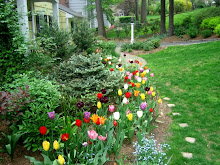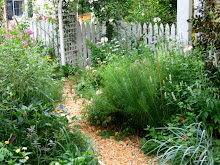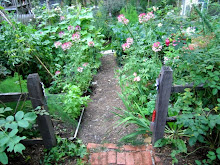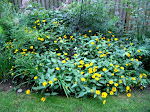This month's Garden Bloggers' Design Workshop at Gardening Gone Wild is on Front Yards. This was one of the topics last year, and given what a common design challenge it is, they've decided to revisit it. Last year, I posted the saga of how I've continued to change my front yard garden from something that was once unremarkably suburban to a series of mixed borders. You can read that prior post here. For this year's workshop, I thought I'd share some hard-earned lessons on a particular design challenge that I've faced, but is not usually addressed in gardening books or magazines: the downward sloping front yard garden.
.
If I tell you that I live on a hill, then you probably imagine a house on the top of a hill. If you don't have a flat front yard, it's more likely that you have an upward sloping one. But what if you have a downward sloping one? How can you make it as beautiful and as inviting as any other? Here are some of the design elements that have worked for me:
.
.
.
.
.
.
Related posts: Heirloom Gardener's Four-Year Makeover of Her Front Garden and The Egg Garden in June: Replacing the Overgrown Evergreen in the Front Corner of Our Home with a Mixed Bed
Welcome to Heirloom Gardener
Friday, June 19, 2009
Front Yard Gardening Design Challenge: Five Ideas for the Downward Sloping Front Yard Garden
Posted by
Julia Erickson
at
11:28 PM
![]()
![]()
Labels: Front Border, Garden Bloggers' Design Workshop, Goldberry Hill
Subscribe to:
Post Comments (Atom)
Search Heirloom Gardener
Labels
- About Blogging
- Annuals/Biennials and Perennials
- Autumn Garden
- Books and Movies
- Botanical Gardens
- Bulbs and Tubers
- Children's Garden
- Chrysanthemum
- Clematis
- Container Gardening
- Crocus tommasiniasus roseus
- Cut and Forced Flowers
- Cutting and Rose Gardens
- Dahlias
- Deep Thoughts About Gardening
- Egg Garden
- Fences Arbors Walls and Paths
- Floral arrangements
- Front Border
- Fun Stories About Gardening
- Garden Bloggers' Bloom Day
- Garden Bloggers' Design Workshop
- Garden Planning
- Gardening Blogs
- Gardening Tools and Structures
- Gardening with Children
- Goldberry Hill
- Heirloom and Organic Food
- Hibiscus
- Holidays
- Hydrangeas
- Japanese Beautyberry
- Lilies
- Mixed Borders
- New Jersey / Local Interest
- Nurseries
- Online Gardening Resources
- Peonies
- Pest Control
- Picture This Photo Contest
- Piet Oudolf
- Poppies
- Propagation and Seeds
- Pruning and Maintenance
- Roses
- Seed Heads
- Self Seeders
- Shrubs
- Spring Garden
- Summer Garden
- Trees
- Wildlife in the Garden
- Winter Garden
- Zinia
Blog Archive
-
▼
2009
(257)
-
▼
June
(41)
- Iceburg (1958) Floribunda Rose in the Oak Tree Garden
- Molineaux David Austin Rose in the Front Border
- Old Blush (1752) China Rose in the Front Border
- Baby Faraux (1924) Polyantha Rose outside the Chil...
- Delphinium in front of the Bird Garden
- Ladybug (Coccinellidae) Pupai
- How to Protect the Vegetable Garden from the Groun...
- Front Yard Gardening Design Challenge: Five Ideas...
- Gardening Gone Wild's Picture This Photo Contest f...
- Tausendschon (1906) or Thousand Beauties Rambler R...
- Mayflower (2001) David Austin English Rose in the ...
- Gardenia (1899) Rambler Rose on the Arbor to the W...
- Rosa Virginiana in the Bird Garden
- Hansa (1905) Rugosa Rose in the Front Border
- Excellenz von Schubert (1909) Polyanthus Rose in t...
- A Different Garden Tour of Philadelphia Gardens fr...
- Thomas Affleck (1998) from Antique Rose Emporium o...
- Cardinal de Richelieu (1840) Gallica Rose in the L...
- Belinda (1936) Hybrid Musk Rose in the Bird Garden
- Garden Bloggers' Bloom Day - June 2009: Roses and...
- Oriental Poppies (Papaver orientale) in the Egg Ga...
- Midsummer Garden Party at Fordhook Farm featuring ...
- Some of the peonies in bloom throughout the gardens
- Pictures of Piet Oudolf's High Line Gardens
- NatureFind: how to find public parks, campsites, a...
- Styrax japonicus tree and flowers in bloom on Gold...
- Zombie Blogs: Why 95% of Blogs Are Abandoned
- Piet Oudolf's High Line Gardens Open in New York City
- The Egg Garden in June: Replacing the Overgrown E...
- Green Hour: how to find public parks, campsites, ...
- WSJ story about Danielle Hahn's Rose Story Farm by...
- Ask Heirloom Gardener: Are Heirloom Roses Hard to...
- The Rose Garden in Summer: Madame Ernest Calvat (...
- The Rose Garden in Summer: Madame Plantier (1835)...
- The Rose Garden in Summer: Ispahan (1832) Damask ...
- The Rose Garden in Summer: Therese Bugnet (1950) ...
- The Rose Garden in Summer: Leda (1827) Damask Rose
- The Rose Garden in Summer: Alchymist (1956)
- The Rose Garden in Summer: Russell's Cottage Rose...
- The Rose Garden in Summer: Great Western (1840) B...
- The Rose Garden in Summer, Part I: A Walk Down th...
-
▼
June
(41)























14 comments:
Just beautiful!
You've done a wonderful job with your front yard. It's gorgeous!
Hi there. This was a great post to read, and I especially enjoyed following the links to other places in your blog. The evolution of your gardens is very interesting indeed. I also went and visited the post about your Egg Garden, and the one about the Deer Fence, and the previous design workshop post on this subject.
I wish I had a hill to garden on. Any slopes at the Havens were created by us!
From one gardener (A fairly new one too at quite an advanced age!)to another, this is simply lovely!
I followed the link from the Egg Garden to this post. This has some great points, even for those of us who slope in the opposite direction.
I enjoyed reading this post. You have found excellent ways to manage your slope. Your gardens are beautiful, so full and lush!
Oh my - how did I miss leaving you a comment on this wonderful post earlier? Sorry about that. It's a beautiful and inspiring story that's suited for several of the GGW Design Workshops. Thanks so much for sharing this with us!
OMG, I didn't realize you had such a tough slope to work with. I wonder how I missed this important bit of information?? Anyway, you have just worked wonders with this difficult situation. I like the aspect of privacy. I have planted all around our house too. It is on a busy corner. I like my privacy despite people passing by going to the local wal mart and during the school year all the students going to the big local highschool pass by too. UGH... I have achieved a quietude. I am grateful for that. I would love to have more color in the garden though. I look at your colorful garden and sigh longingly.
You've done a wonderful job! I hope someday I can have gardens that look like that!
I noticed your paving stones & was wondering if that was the primary walk up to your house??
I ask because I have to replace the sidewalk up to my front door & the cheapest/nicest looking method would be paving stones but I hesitate because I don't know how it'd be to shovel snow off of in the winter.
I love all the pictures of your flowers - I've been emailing them to my Mom & it's really been brightening her day!
Sam,
We previously had paving stones, but replaced them with the bluestone for two reasons:
1. The paving stones became uneven and were a hazard to walk on.
2. The bluestone was more aesthetically pleasing.
Both were fine in the snow, but neither is smooth for a shovel, so you need to remove most of the snow and then add salt or an ice melter to prevent a build-up of ice.
However, the bluestone was significantly more expensive.
You can read more about the bluesteon on this post:
http://heirloomgardener.blogspot.com/2008/05/garden-bloggers-design-workshop-stone.html
-Heirloom Gardener
Thanks for your response.
I'll definitely avoid the paving stones then. There's a small quarry & landscape rock place not far from our house - I'll see what they have there for rock. Being a local quarry they might be cheap.
Thankfully it's a short walkway that I need to tackle - maybe 10ft so I might be able to pull off stone. I've had quotes for a regular cement walk so I at least have numbers to compare the cost of stone to.
That is beautiful blue stone & the pebble path looks nice too.
Have a good afternoon :-)
I live at the bottom of a slope so that several neighbors rain water all flows to my yard. All my soil keeps washing away and plants are dying. I have to put in more dirt and mulch several times a year. Other than a major ditch to catch the water and put in drainage pipes, I can't see a solution to this problem. Do you have any ideas?
Thanks,
Missy
I have kinda the same problem. Last week I had a structural engineer (friends husband) at my place and he had a novel idea instead of a ditch or french drain - he told me to put paving stones down in such a way that they'd slope the water off into the drive way. He said it's need to be a 2ft drop from my back yard to my driveway (probably about 1000 ft)
He said there's two ways to figure the slope:
One was to dig & put the line of pavers in and then turn on the garden hose to see if the water runs the desired direction.
The other was he said to run a level string on stakes from the beginning point to the end point and measure down at the end point - 2ft from the string and then work my way back putting each paver in a little higher then the previous & using the string to measure as needed.
I don't know if that makes sense - I need more coffee yet this morning & I don't have my 2 pages of notes from him with me.
One other idea is my brother ran PVC pipes with holes drilled in the top under 3 sides of his yard to help drain water form the house - he put the dirt & grass back over it so you can't tell it's there unless you notice the drain pipe sticking out. Too much work for me but, if the paver idea doesn't work well enough then I'm going to try that.
PS - the pavers I'm talking about are 1ft by 2ft ones, not ones the size of a regular brick although regular brick would probably work - just be more narrow.
Post a Comment